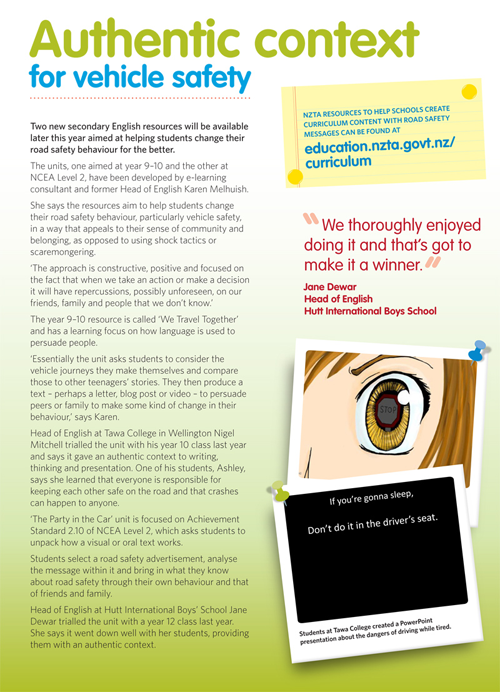Year 10 students undertake a statistical enquiry cycle which gets them discussing safe speeds.
Arts students design and produce posters with their own safety messages aimed at the iPod generation.
Secondary students explore the journeys they make as passengers and write persuasively about the need for safe decisions.
Students get hands-on when learning about forces in the context of safe road travel.
English: Creating persuasive texts as passengers
Secondary students explore the journeys they make as passengers and write persuasively about the need for safe decisions.
Interviewees: Karen Melhuish, consultant writer, and Nigel Mitchell, Lead teacher trialler at Tawa High School.

http://www.slideshare.net/nmitchelltawa
The unit we developed is called “We Travel Together”. The focus was on the journeys that students took and who they travelled with and why.
The unit of work is deeply embedded in the curriculum. It has a rightful place in the English curriculum and at the same time it focuses on a clear road safety outcome. It’s not an add-on.
The big road safety idea was that passengers could impact on all decisions taken in cars (for example, use of seatbelts, driver tiredness, lowering distractions), whether or not they are drivers. The focus for English was on understanding and using persuasive texts (oral, written, visual) to achieve an outcome.
We were looking for an end result where students could have a positive impact on levels of risk in their own journeys. It was about students engaging deeply in a context and then being able to do something with the understandings they gained. We wanted them to be able to generalise, make recommendations persuasively, and speak up as passengers when appropriate.
Citizen and community focuses are important, not just road safety messages. The big challenge was to make it meaningful for students, not just road safety lip service. The breadth of the design enabled each student to find something relevant for them.
The unit was carefully planned and explicit about effective pedagogy, values, key competencies, and learning area content. The SOLO Taxonomy, a model of levels of understanding, is used as a scaffold behind the scenes to structure questions and ensure a deep learning focus. The unit not only encourages, but demands deep thought. Things that are deeply learnt are more likely to endure over time and lead to changed actions.
We started by looking at students’ own journeys, what it meant to be a passenger in a car at age 14 and how much influence students had over various people who drove them (friends, parents, other students’ parents, boyfriends). We also examined texts (oral, written, visual) that were trying to persuade students to do something.
We developed research questions to investigate and students used the SOLO Taxonomy to critique the quality of their questions. Students examined what others had been saying via selected web material put together on LiveBinders, a web tool that displays selected websites on tabs. They used Google Docs to put their ideas together and teachers provided feedback on them via Google Docs.
There were many opportunities for students to make a persuasive point. They used a range of media, for example, stop-frame animations, posters, essays and multimedia presentations. They focused on their ability to influence the most important road safety issues for them, within the broader theme of being a passenger; for example:
- their parents being tired
- distractions like putting on make-up in the car
- being uncomfortable with the driver’s speed.
What’s surprising is the number of variations students came up with.
At the end of the unit, students were required to produce a persuasive text that would have an impact. They learnt that it is okay to ask someone to slow down. They learnt that it is easier to give some people the message than others and they practised giving messages in situations that might be harder – for example, another student’s parent. Students believed telling another student’s parent something about their driving might be harder to recover from if something went wrong, because the relationship was not so close. They learnt to make “I” statements – for example, “I feel uncomfortable…” – to enhance the likelihood the driver might respond positively to their suggestion.
With teenagers you have to be able to get past the “I know this stuff and/or it’s not that relevant to me because I’m invincible” attitude. Choosing a broad and relevant theme and working through an inquiry process with peers helps embed learning and change behaviours and attitudes.
 NZTA Education Portal News - issue 6-2 (PDF, 512 KB)
NZTA Education Portal News - issue 6-2 (PDF, 512 KB)


